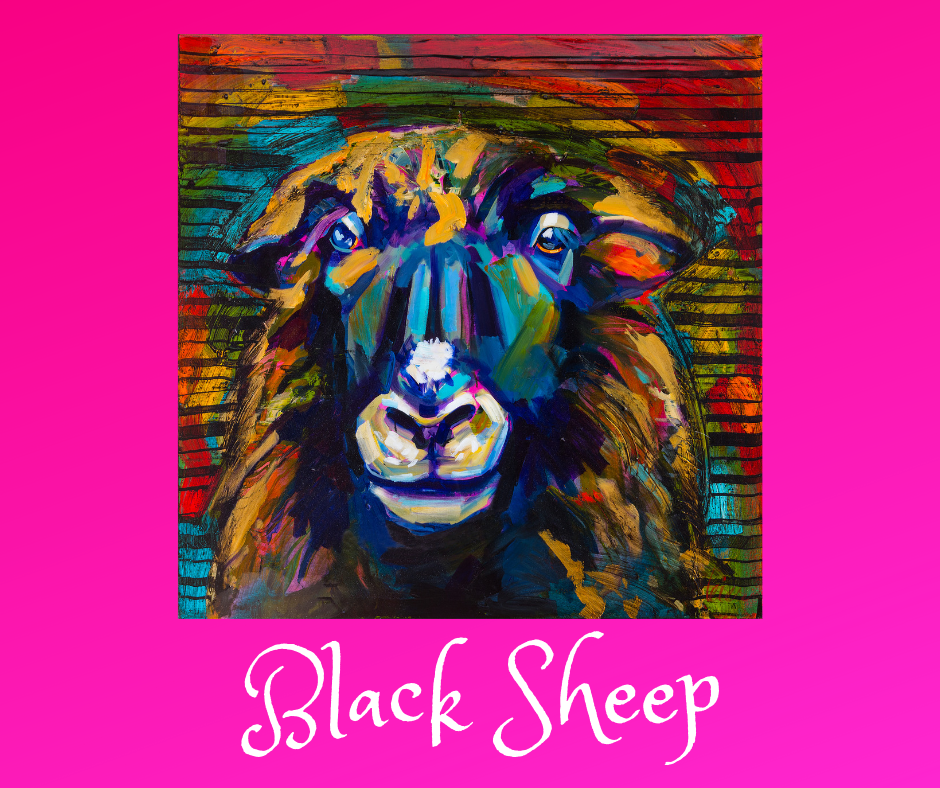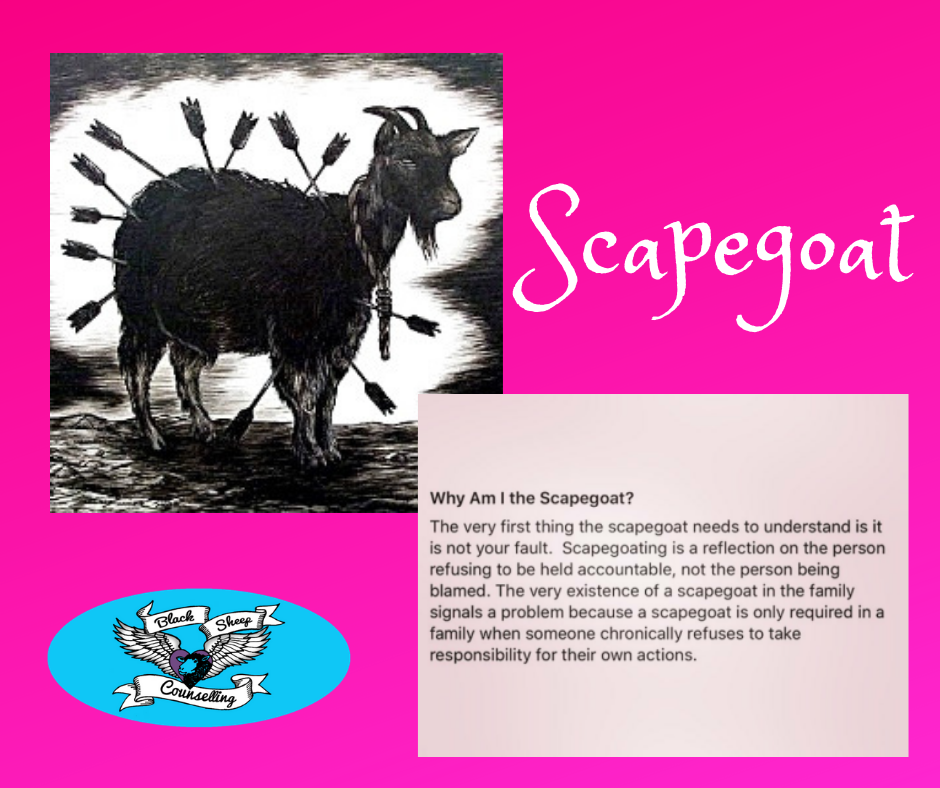BLACK SHEEP

The “black sheep” is a common idiom used to describe someone who is considered disreputable or a disgrace in any group (such as communities, schools workplaces, or religious organizations), however, most people relate the term to describe the “odd one out”, within a family dynamic. A paramount feature of the Black Sheep phenomena is the sense of exclusion one experiences when their values, beliefs, and behaviours do not align with the majority. Being dubbed a “black sheep” has negative connotations that one’s behaviours or beliefs may be considered undesirable or deviant. Identified Black Sheep express feeling “othered”/excluded and often state they feel their existence or way-of-being feels “wrong”, thus giving rise to internalized shame and a belief that they are not worthy of love and belonging from ANYONE (after all, if you don’t feel love and belonging in your family of origin, who else could love you?).
The term Black Sheep originates from the genetic effect in sheep whereby a recessive gene occasionally gives birth to a sheep with black colouring, rather than the common white colour. Black sheep stand out in the flock, and their wool was traditionally considered to be less valuable as it was more difficult to dye the darker wool different colours. Additionally, in the 6th century, the colour black was considered the devil’s mark.
The Black Sheep archetype plays out continuously in literature and pop culture. Examples of storybook characters that have been “othered” are Cinderella and Harry Potter, both orphaned and then abused and neglected by their family members. Superhero characters also face tremendous adversity and feelings of exclusion – their different-ness creates distance and exclusion before it ever gets celebrated.
While the expression Black Sheep is not a clinical term one could find in the Diagnostic and Statistical Manual of Mental Disorders; “DSM” (the “bible” mental health clinicians use for diagnosing), archetypal psychology and literary work consider The Black Sheep is an “archetype” – a universal symbol such as a character, a theme, a symbol, or setting which has common or recurring representation in human culture https://literarydevices.net/archetype/).
Comparable to the Black Sheep archetype, is the archetype of the Scapegoat, as both are presentations that are the result of dysfunctional groups/families. The Black Sheep is a person who causes shame and embarrassment because of deviation from the standards and norms of his/her group. The Scapegoat is the person others project* their shame and blame upon; the function of the Scapegoat is meant to ease the suffering of others by bearing the weight of everyone’s suffering. In dysfunctional families, the ostracism of the Black Sheep and the blaming and criticism of the Scapegoat go hand in hand.
The Scapegoat

The history of the Scapegoat idiom has deep roots. Here’s what the Merriam Webster dictionary has to say:
The History of Scapegoat
Scapegoat has a fascinating history. Today the word is used to refer to one who is wrongly blamed for something, but it originated with an actual goat.
In the Jewish and Christian Scriptures, God ordained a particular day during which the entire nation of Israel would set aside work, and during which the priests would atone for the sin of the whole nation. Among the rituals prescribed was the scapegoat:
And Aaron shall cast lots upon the two goats; one lot for the Lord, and the other lot for the scapegoat. And Aaron shall bring the goat upon which the Lord’s lot fell, and offer him for a sin offering. But the goat, on which the lot fell to be the scapegoat, shall be presented alive before the Lord, to make an atonement with him, and to let him go for a scapegoat into the wilderness. —Leviticus 16:8-10, KJV
The scapegoat carried the sin of the people away with it, thereby cleansing Israel for another year.
The English scapegoat is a compound of the archaic verb scape, which means “escape,” and goat, and is modeled on a misreading of the Hebrew ʽazāzēl (which is probably the name of a demon) as ʽēz ‘ōzēl , “the goat that departs.” More modern translations render scapegoat in this text as Azazel, but the misreading endured and has entered the lexicon.
Source: https://www.merriam-webster.com/dictionary/scapegoat#note-1
Scapegoating is often a way for families to hide problems that they cannot face. Sometimes this is done consciously; however, many therapists would argue that it more frequently happens out of the projecting family members’ awareness. Most people are avoidant to sit in feelings of shame and inadequacy and a common way to discharge these adverse feelings can be to dump them onto another….a Scapegoat. Projecting one’s feelings of discomfort onto another provides the perpetrator some relief and thus a pattern is born, and more perpetrators join in. Family members strive to feel better about themselves by engaging in gossip and case-building about the Black Sheep/Scapegoat. Feeling targeted and bullied in a myriad of ways**, the Black Sheep/Scapegoat responds to being victimized with increased distress, such as anxiety, depression, suicidal thoughts, somatic complaints, dissociation, and maladaptive coping behaviours (such as substance misuse, disordered eating, cutting, et cetera). The perpetrators often band together and express to one another this is “evidence” of the pathology of the “identified patient”. In actuality, the above listed symptoms of distress are a normal response to abnormal circumstances such as oppression and victimization. The identified patient (“IP”), is a clinical term used in family therapy to describe the person in a dysfunctional family who has been selected (most often unconsciously) to lay blame upon to draw attention away from family members’ own maladaptive behaviours, inner conflicts, and often intergenerational patterns of familial dysfunction (such as emotional cut-offs). The IP and Scapegoat are one and the same: a diversion from the truth – akin to the biblical sacrificial goat, they are used to discharge the sins of others. Dysfunctional families have a vested interest in keeping the Black Sheep/Scapegoat around to make themselves feel better (one may not be doing great in life, but, hey, look at how f%^&ed up the Black Sheep is!). Once the victimized person speaks up or tries to illuminate the truth of what is happening, they are usually ostracized by the silent treatment/stonewalling. Such cut-offs can appear to place an end to communication, but in many ways the action is cruel and abusive – it communicates “You’re not worth responding to. Your thoughts and feelings don’t matter to me. You don’t matter to me.” The silent treatment and stonewalling activate feelings of abandonment in the brain. Research indicates that such behaviors are a form of ostracism which activates the anterior cingulate cortex, the same part of the brain that detects physical pain. Ostracism is often the activating event that brings the victimized individual to seek mental health support. Estrangement from an abusive family or environment may be the healthier option for the Black Sheep/Scapegoat. Even when it is wholly warranted, this comes with societal stigma from people who cannot fathom the adage that “family is everything” isn’t true for everybody – this can unfairly place their ignorance and judgement onto the victimized individual thus contributing to feelings of shame and unworthiness.
What can be done to assist those suffering from Black Sheep/Scapegoat phenomena?
Mental health support from someone specializing in relational trauma is paramount. Because trauma resides in the body, therapy must include mindfulness and somatic approaches that work from the outside in (if we could “think” our way to wellness, we would). Our emotions register in our body. By deepening our awareness of the sensations felt in our body, it helps connect our experience to an increased understanding of the language of emotions. When our thoughts and feelings or who we are as a person is not validated by those around us, it causes emotional repression, thus keeping us “stuck”. Emotional suppression causes suppressed immune systems, which contributes to autoimmune diseases, cancer, dementia, metabolic syndrome, and early death. Black Sheep Counselling specializes in relational trauma, through a variety of evidence-based techniques. If you have experienced being “othered”, you are not alone, nor do you have to navigate your journey towards healing alone.
Final thoughts
Being the Black Sheep comes with gifts, such as the freedom to truly embrace authenticity. Akin to the Superhero who initially struggled with exclusion but eventually is esteemed for their uniqueness, so too can the Black Sheep find genuine belonging by simply being their authentic selves. The Black Sheep has a felt sense of knowing that trying to fit in, hurts. Shame and resiliency researcher, Brené Brown has identified that the opposite of belonging is fitting in. Gabor Maté asserts that our number one human need is for attachment and our second need is authenticity. The family Black Sheep will automatically adapt their authenticity for attachment/bonding in their family of origin. Once free from having to hide who they truly are, Black Sheep can embrace their authenticity and cultivate a family of their choosing.
Black Sheep also almost always have a greater sense of empathy and compassion towards others, as they embody a felt sense of truly knowing the pain of exclusion. Pain can create empathy, and empathy can foster deepened connection. We Black Sheep are a unique tribe. Once free from the toxic projection of others, we can find belonging with Self and with others, and truly THRIVE!


*for more on projection: https://blacksheepcounselling.com/2017/08/projection/
** for more on how abuse towards a Black Sheep plays out: https://blacksheepcounselling.com/2018/08/gaslighting/

References:
Banich, M. T., & Compton, R. J. (2017). Cogntive neuroscience (4th ed.). Belmont, CA: Wadsworth, Cengage Learning. Gabor Mate (2004). When the body says no: The hidden costs of stress. Toronto, ON: Vintage Canada. Sadock, B. J., Sadock, V. A., & Ruiz, P. (2007). Kaplan and Sadock’s synopsis of psychiatry: Behavioral Sciences/Clinical Psychiatry (10th ed.). Philadelphia, PA: Lippincott, Williams, and Wilkins.
Shore, A. N. (2003). Affect dysregulation and disorders of the self. New York, NY: Norton.
Szyf, M. (2013, July 27). Epigenetics of early life adversity: The implications from mental health. Brain Development & Learning Conference. UBC Interprofessional Education.
van der Kolk, B. (2014). The body keeps the score: Brain, mind, and body in the healing of trauma. New York, NY: Penguin Books.
